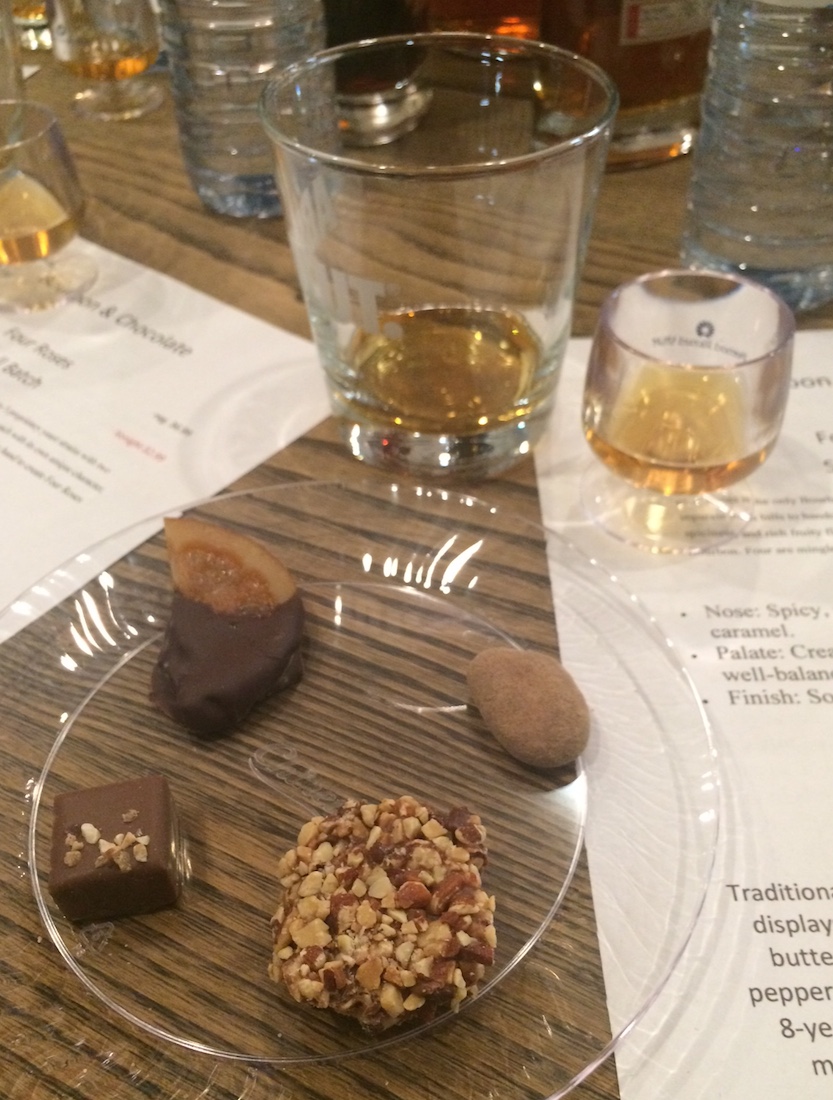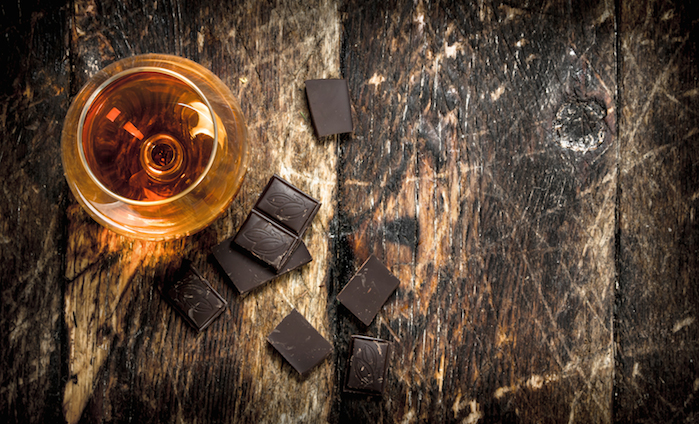What goes better together than whiskey and chocolate? They share complimentary sweet, toffee or caramel flavors. Or if a whiskey is a little weak or too bold in some areas, the proper candy pairing can help offset those flaws.
Matching chocolate with whiskey was the focus of a tasting last week at Castle Hill Chocolate in Newtown, CT. The artisanal candy store offered four treats alongside the same number of bourbons, which were supplied by nearby Yankee Wine & Spirits, who co-hosted. The whiskeys came from Four Roses as well as Connecticut’s own Litchfield Distillery.
First up was Four Roses Small Batch Bourbon paired with a Naples orange slice dipped in dark chocolate. The chocolate was pure cocoa butter — surprisingly not bitter for being dark.

“This is an easy pairing, because orange and whiskey always go together well,” explained Erica Sullivan, owner of Castle Hill Chocolate. “I like to think of this pairing as a deconstructed Old Fashioned.”
Shared flavors of sweet subtle caramel matched up. The dark chocolate helped mellow the spicy kick in the Four Roses’ finish. Nibbling the candy and then sipping the whiskey also pulled out more caramel and vanilla notes, while the Naples orange enhanced the spirit’s fruitier tones. A fine cocktail of flavors, indeed.
Up next was a toffee pecan cinnamon chocolate with Litchfield Distillery Batchers Bourbon. The candy was infused with cinnamon and rolled in cocoa powder, and had a nice peppery kick. Which helped make up for the whiskey’s shortcomings.
Litchfield Distillery opened in Litchfield, CT, in 2014. Like many new distilleries it purchased and bottled pre-aged product to help recoup upfront investment costs. Batchers Bourbon represents whiskey made entirely in Litchfield, aged at least two years. While commendable for being 100% Connecticut-made, such a young whiskey usually lacks the time in barrels to mellow and develop more complex flavors.
So it was with Batchers Bourbon. Cereal grains and sharpness on the palate were typical signs of younger whiskeys not quite ready for sipping status. But with the candy, the cinnamon spice deepened the whiskey by adding missing flavors, while the chocolate mellowed the bourbon’s sharp (or bright) bite. The right chocolate pairing can soften and fill in the blanks of a young whiskey.
Poured third was Litchfield Distillery Port Finished Bourbon. This is 10-year-old bourbon they bought and then finished for six months in port barrels. At 100 proof it’s an oak-forward punch in the mouth. Tame that with water and you unearth more of the port flavor. This would be a lovely whiskey over an ice ball.
Sullivan paired it with a toasted almond-butter chocolate covered in nuts. When drinking whiskey heavy on oak, Sullivan recommended nuts as an ideal way to cut through oaky tones. A bite of candy and then a sip of this bourbon revealed more of the caramel and vanilla notes lost behind all that oak and port. Another excellent pairing.
Last was Litchfield Distillery Coffee Bourbon. The company steeped locally sourced coffee grinds in cold distilled water for 24 hours, and then infused this brew into their own bourbon during the proofing process. Which resulted in flavors of coffee, milk chocolate, and Cocoa-Cola in this smooth-drinking whiskey made for mixed drinks and boozy ice cream floats.
With this Sullivan served a chocolate infused with ground hazelnut and then enrobed in milk chocolate and more hazelnut. The dark-coffee taste of the whiskey mixed perfectly with the sweeter hazelnut of the candy. Enjoyed together, the pairing was like drinking a milk stout beer. Yummy.
Sullivan said she received many requests for a chocolate/whiskey class, “more so from women.” She believed women think of chocolate as a way to par down the spirit’s spicy bite. This points towards two current trends in the category: more female consumers gaining interest in whiskey, and more people understanding its delicious uses alongside dessert.
Kyle Swartz is managing editor of Beverage Dynamics magazine. Reach him at kswartz@epgmediallc.com or on Twitter @kswartzz. Read his recent piece Why Age Whiskey at Sea?






